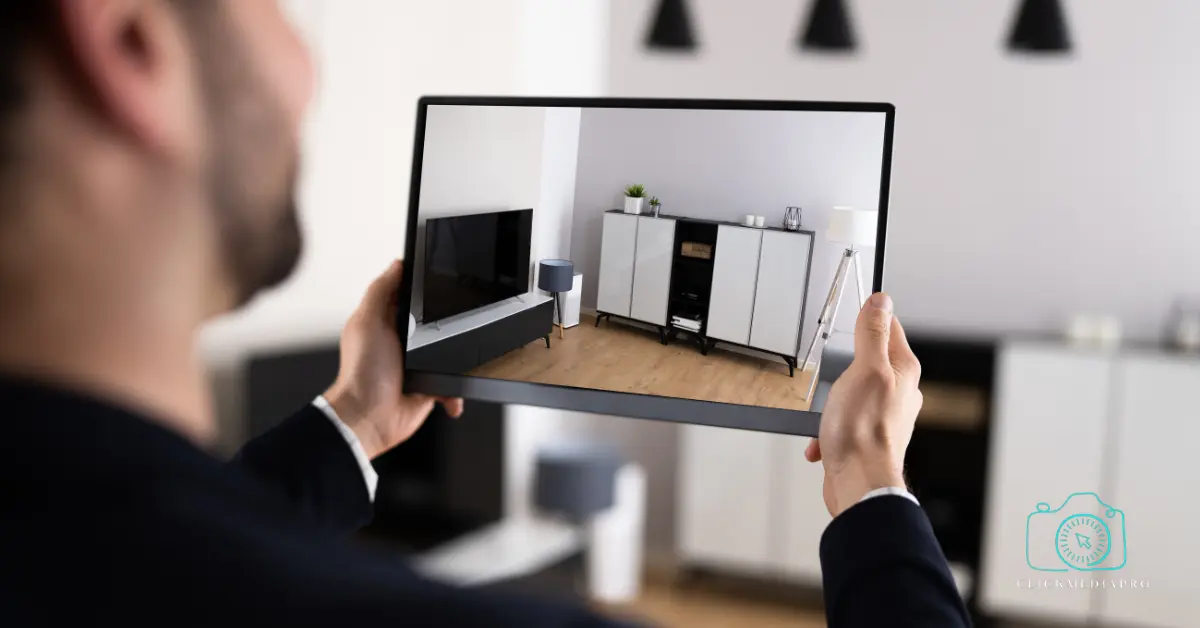Selling a house in today’s market involves more than just listing a property. In a fast-paced digital era, where convenience and efficiency drive decision-making, potential buyers often seek innovative ways to explore homes without dedicating an entire day to property visits. This is where virtual tours in real estate come into play, offering an immersive, tech-savvy solution to streamline the home-buying process.
Virtual tours are not just a novelty; they are a transformative tool reshaping how buyers interact with real estate. Whether through 360 virtual tours or advanced 3D Matterport virtual tours, these technologies make property showcasing dynamic, detailed, and accessible. Let’s dive deeper into what virtual tours are, their advantages, and how they’re changing the landscape of real estate marketing.
Table of Contents
ToggleWhat Is a Virtual Tour in Real Estate?
A virtual tour allows prospective buyers to explore a property online in a detailed and interactive manner. By presenting a high-quality visual representation of the property, buyers can “visit” the house without leaving their current location. This capability saves time, energy, and resources while offering a realistic view of the property’s layout and features.
The Evolution of Virtual Tours
Traditionally, real estate photography and videography served as the primary visual tools to market properties. While effective, static photos and videos have limitations—they can only capture so much of a property’s essence. Modern virtual tour technology, however, fills this gap by delivering an experience that mimics an in-person walkthrough.
With virtual tours, buyers can interactively navigate through a home, view rooms from multiple angles, and get a sense of the property’s spatial flow. These features allow buyers to shortlist properties more efficiently, often without the need for an initial physical visit.
Types of Virtual Tours
There are two main technologies dominating the virtual tour space:
- 360 Virtual Tours
- 3D Matterport Virtual Tours
While both aim to create a digital walkthrough of a property, they differ significantly in terms of quality, experience, and complexity.
360 Virtual Tours
A 360 virtual tour consists of panoramic images stitched together to create an interactive online experience. The images are captured using a 360-degree camera and then processed using specialized software. Users can navigate between these panoramic images to explore different areas of the property.
Advantages of 360 Virtual Tours
- Affordability: Creating a 360 virtual tour is relatively inexpensive compared to other options.
- Quick Turnaround: The process is faster as fewer images are required, making it ideal for tight schedules.
Disadvantages of 360 Virtual Tours
- Limited Viewing Angles: Due to the limited number of images captured, buyers cannot view rooms from every perspective.
- Lack of Smooth Navigation: Movement between images can feel disjointed, detracting from the immersive experience.
Example of 360 Virtual Tour Quality
High-quality 360 tours, like those produced by professional studios, can still provide a decent user experience. However, these tours often fall short of capturing the level of detail modern buyers expect.
3D Matterport Virtual Tours
A 3D Matterport virtual tour takes the concept of digital walkthroughs to the next level. Using specialized cameras, a 3D model of the property is created. This model includes accurate spatial data, allowing users to rotate the “dollhouse view,” enter individual rooms, and even measure dimensions within the virtual space.
Advantages of 3D Matterport Virtual Tours
- Exceptional Quality: The technology provides a seamless and realistic experience, with smooth navigation and detailed visuals.
- Comprehensive Viewing Points: With more images captured, buyers can explore rooms from nearly any angle.
- Measurement Capabilities: Buyers can measure room dimensions, ceiling heights, and window sizes directly within the virtual tour.
- Floor Plan Integration: The ability to generate precise floor plans enhances the user experience and provides additional clarity.
Disadvantages of 3D Matterport Virtual Tours
- Higher Costs: The complexity of creating a 3D tour increases its price.
- Time-Intensive: Photographers need more time on-site to capture the necessary data.
Example of 3D Matterport Tour Excellence
Top-tier 3D tours produced by professional studios use advanced cameras to deliver unmatched clarity and detail, ensuring a truly immersive experience.
Factors Influencing Virtual Tour Quality
Several key factors determine the quality of a virtual tour, regardless of whether it’s a 360 or 3D Matterport tour:
1. Camera Quality
The quality of the camera plays a crucial role in producing sharp, detailed images. High-resolution cameras ensure that every detail is captured, from intricate moldings to the textures of walls and floors.
- Low-Quality Cameras: Often result in blurry, grainy images, especially in poorly lit areas.
- High-Quality Cameras: Deliver vibrant, crisp visuals that enhance the overall appeal of the property.
2. Lighting Sensitivity
Dark or poorly lit spaces can be challenging to capture. Professional-grade cameras with excellent light sensitivity produce better results, maintaining image clarity and contrast even in low-light conditions.
3. Number of Shooting Points
In 3D tours, the number of shooting points directly impacts the user’s navigation experience. More shooting points allow for smoother transitions and provide a more comprehensive view of the property.
How Virtual Tours Benefit Real Estate Marketing
Virtual tours have become a cornerstone of effective real estate marketing. Here’s why:
1. Increased Buyer Engagement
Properties with virtual tours generate higher levels of buyer interest. By offering an immersive experience, buyers are more likely to spend time exploring the listing.
2. Time Efficiency
Virtual tours enable buyers to narrow down their options before committing to an in-person visit. This saves time for both buyers and agents.
3. Wider Reach
Out-of-town or international buyers can explore properties without traveling, making virtual tours an invaluable tool for reaching a broader audience.
4. Higher Conversion Rates
Listings with virtual tours often convert better because they provide transparency and reduce buyer hesitation.
Stay informed about the latest luxury real estate developments in Toronto by visiting Wedu.ca and exploring its expert blog posts. For comprehensive insights into the housing market and valuable resources for buyers and sellers, check out the Wedu blog. Click Media Pro specializes in professional real estate photography in Toronto, capturing stunning images that showcase properties in their best light.
Real Estate Applications for Virtual Tours
Virtual tours are not limited to residential properties. They are also highly effective for:
- Luxury Homes: Showcasing expansive estates with intricate details.
- Commercial Properties: Helping businesses assess office spaces or retail locations remotely.
- Vacation Rentals: Giving potential renters a comprehensive view of vacation properties.
Future of Virtual Tours in Real Estate
As technology continues to evolve, virtual tours will become even more sophisticated. Innovations such as augmented reality (AR) and virtual reality (VR) are likely to enhance the experience further, allowing buyers to customize spaces or view staged furniture in real-time.
Choosing the Right Virtual Tour Solution
When deciding between a 360 and a 3D Matterport virtual tour, consider the following:
- Budget: 360 tours are more affordable but offer limited features.
- Property Type: High-end or luxury listings may benefit more from 3D tours.
- Buyer Expectations: If your audience values detail and quality, invest in 3D tours.
Conclusion
Virtual tours are revolutionizing the real estate industry by making property exploration convenient, immersive, and accessible. Whether through a quick 360 virtual tour or a detailed 3D Matterport experience, these tools are invaluable for both buyers and sellers.
By understanding the differences, benefits, and applications of each type of virtual tour, real estate professionals can effectively leverage this technology to stay ahead in a competitive market.
Investing in professional virtual tours is no longer optional—it’s a necessity for showcasing properties in the digital age.
FAQs About Virtual Tours in Real Estate
1. What is a virtual tour in real estate?
A virtual tour is an interactive digital walkthrough of a property that allows potential buyers to explore its features, layout, and design from their device without needing to visit in person.
2. What is the difference between a 360 virtual tour and a 3D Matterport virtual tour?
- 360 Virtual Tour: A series of panoramic images stitched together, allowing navigation between specific points. It’s affordable and quick to create but lacks smooth transitions and comprehensive views.
- 3D Matterport Virtual Tour: Uses advanced technology to create a 3D model of the property, offering smooth navigation, multiple viewing angles, and additional features like measuring room dimensions.
3. Why are virtual tours important in real estate?
Virtual tours provide an immersive experience, helping buyers shortlist properties efficiently. They save time, reach a wider audience, and offer greater engagement compared to static photos or videos.
4. Are virtual tours only for luxury real estate?
No, virtual tours can be used for all property types, including residential homes, commercial spaces, vacation rentals, and even rental properties. However, high-end properties often benefit the most from detailed 3D Matterport tours.
5. How much does it cost to create a virtual tour?
The cost varies depending on the type of tour:
- 360 Virtual Tours are more budget-friendly due to their simplicity.
- 3D Matterport Tours are more expensive because of the advanced technology, additional time, and equipment required.
6. What equipment is used to create virtual tours?
Professional-grade 360 cameras or specialized 3D cameras like Matterport Pro2 are typically used to capture high-quality images and spatial data.
7. Can I measure room dimensions in a virtual tour?
Yes, in 3D Matterport tours, you can measure dimensions like room sizes, ceiling heights, and window widths directly within the tour.
8. How long does it take to create a virtual tour?
- 360 Virtual Tours: A few hours to capture and process.
- 3D Matterport Tours: More time-intensive, often taking several hours to capture and additional time for processing.
9. Do virtual tours replace the need for in-person visits?
While virtual tours are an excellent tool for initial exploration, many buyers still prefer an in-person visit before making a final decision.
10. Can virtual tours increase the chances of selling a property?
Yes, properties with virtual tours tend to attract more interest, increase buyer engagement, and often sell faster due to their transparency and immersive nature.
11. Are virtual tours compatible with all devices?
Yes, most virtual tours are accessible on desktops, tablets, and smartphones, ensuring a seamless experience across devices.
12. Can virtual tours be shared on social media or real estate websites?
Absolutely! Virtual tours are highly shareable and can be embedded in real estate websites, social media platforms, and MLS listings to reach a broader audience.
13. Are virtual tours suitable for properties under construction?
Yes, virtual tours, particularly 3D Matterport tours, are ideal for showcasing pre-construction and under-construction properties by providing virtual staging and floor plan views.
14. How do virtual tours benefit real estate agents?
Virtual tours save time, enhance marketing efforts, attract more qualified leads, and give agents a competitive edge by offering buyers a more immersive experience.
15. What should I look for in a virtual tour service provider?
Choose a provider with:
- High-quality cameras for crisp images.
- Expertise in both 360 and 3D Matterport technologies.
- Experience in creating realistic, smooth, and user-friendly tours.

